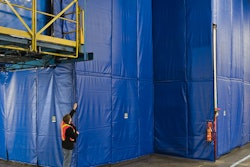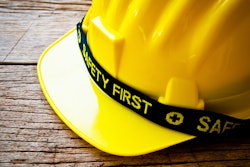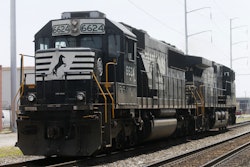Maintaining safety and security at the loading dock is critical for any type of business. In the food industry, it extends beyond workers to the loading dock and to the people who ultimately consume the food those workers are handling. Unsanitary practices can lead to spoiled or tampered-with food, mass illnesses and federal fines and sanctions for manufacturers.
Protecting workers at the dock and ensuring proper food handling practices are performed is easier said than done. Fortunately, there are ways to improve both safety and security with the right system of dock equipment. And with more aspects of the Food Safety Modernization Act (FSMA) coming into effect in 2017, it’s even more critical for facilities that regularly manufacture or process food to pay attention to the loading dock.
Following sanitary rules
Sanitary transport is an important law related to FSMA that goes into effect on April 1. No fooling. It covers anyone involved in the shipping, receiving, loading and carrying of food in the U.S. (and to be distributed in the U.S.) by motor vehicle or rail. Here are the key points:
- Vehicles and transportation equipment must be designed for easy cleaning and maintenance to safely transport food.
- Transportation operations must provide adequate measures to ensure food safety, including proper temperature controls, protection from cross-contamination, prevention of ready-to-eat food from touching raw food, and prevention of food contamination from non-food items in the same – or previous – load.
- Training carrier personnel in sanitary transportation and documentation of training.
- Written maintenance records of all food safety procedures for up to 12 months.
This rule extends safeguards originally envisioned in the Sanitary Food Transportation Act (SFTA) of 2005, which was developed as the result of illness outbreaks attributed to human and animal food contaminated during transportation.
Note that small businesses employing fewer than 500 people and motor carriers with less than $27.5 million in annual receipts have until April 1, 2018 to comply with this rule. Furthermore, food transportation operations with less than $500,000 in annual revenue are exempt from this rule. That being said, complying with the rule would be in line with best practices.
Compliance at the loading dock
Ensuring that loading dock operations comply with FSMA’s sanitary transport means several challenges must be addressed. A good training program that teaches best practices to maintain the cold chain and to prevent cross contamination is a starting point. Making sure employees follow the training is another essential step. But there’s more to it than that.
Perhaps most overlooked in these guidelines is that the equipment used at the loading dock needs to be designed for easy cleaning and maintenance. Outdated and non-industry-specific equipment can lead to potential cargo theft and tampering of food product. In fact, food is being stolen at the highest rate of any product category in the U.S., with 28 percent of all thefts involving food and beverage products.
While the numbers are alarming, food facility managers do have options to get in line with FSMA standards and prevent theft and tampering. The gold standard is to implement a “drive-through” application at the loading dock with a system of FSMA-compliant equipment. This loading dock solution can prevent food product from being tampered with or stolen.
Make it a drive-through
A drive-through application at the loading dock allows facilities to meet most of the best practices standards required in FSMA sanitary transport. This method essentially connects elements throughout the supply chain together with virtually no chance for tampering or spoilage. This is because security seals are only broken inside facilities. To achieve a drive-through set-up requires more than just one piece of equipment – it entails a system of equipment that works together.
It starts with the restraint
Automatic vehicle restraints have become ubiquitous at loading docks. They automatically wrap around a trailer’s rear-impact guard (RIG) or rear wheels to secure the trailer to the loading dock when it backs into position. They provide safety for workers at the loading dock and can prevent potential tampering that might occur if a trailer was able to pull away from the facility.
Some automatic restraints feature a control panel that can be integrated into building management or security systems, providing another level of security and protection against external tampering. The most advanced restraints will actually re-fire if there is tampering or the trailer attempts to pull away when in the locked position.
Some models can even help secure intermodal overseas container chassis, which have become increasingly common across the food industry supply chain.
Vertical-storing levelers
Creating a smooth bridge from the trailer to inside the facility is a matter of operational safety and efficiency. While traditional levelers perform this function admirably, not all types allow for drive-through capabilities. A vertical-storing leveler can.
Levelers that store vertically – inside the facility – help maintain cold chain integrity, environmental control and security. This is because security seals can be broken and trailer doors can be opened and closed inside the loading dock instead of on the drive approach, which improves cold chain integrity and enhances the security of products and processes.
Unlike a pit-style leveler, a vertical leveler (when in the stored position) allows the loading dock door to close directly on the pit floor instead of on the leveler. This difference effectively reduces energy lost by minimizing outside air infiltration.
Additionally, the vertical design makes it easy to clean or wash down the pit floor when the leveler is in the upright and stored position. And since ease of cleaning is a major component to sanitary transport rules, this type of leveler is recognized as a major upgrade in new FSMA standards.
Properly sealing the dock perimeter
The third component in creating a drive-through application is ensuring a complete environmental seal between the back end of the semi-trailer and the inside of the loading dock. This connection is vital in keeping wind, rain, dust, bugs, and other contaminants outside the building.
Some of the newest dock shelters have been specifically designed with the food industry in mind. In particular, shelter designs that complement the vertical storing dock leveler and allow trailer doors to be opened inside of the building are ideal. Through special design features, shelters ensure tight sealing against trailer sides, across the full width of the trailer top and at the corners, without interfering with trailer doors being opened and closed after the trailer has been parked at the dock.
An effective dock sealing system also helps prevent weather-related product damage and contamination, protecting and securing the integrity of products as they move in and out of a facility during manufacturing, processing, and shipping.
Improve food safety with a drive-through loading dock
Implementing a drive-through application at the loading dock isn’t just a matter of meeting new FSMA standards; it’s about getting in line with best practices to ensure the delivery of safe food to consumers. When the opportunity arises to update loading dock equipment, food facility managers should consider looking at automatic vehicle restraints that work with a variety of trailers (including intermodal container chassis), vertical-storing levelers and dock shelters that can accommodate them.
The information provided herein is provided as a general reference regarding the use of the applicable products in a specific application. This information is provided without warranty. It is your responsibility to ensure that you are using all mentioned products properly in your specific application and in accordance with all laws and regulations.






















